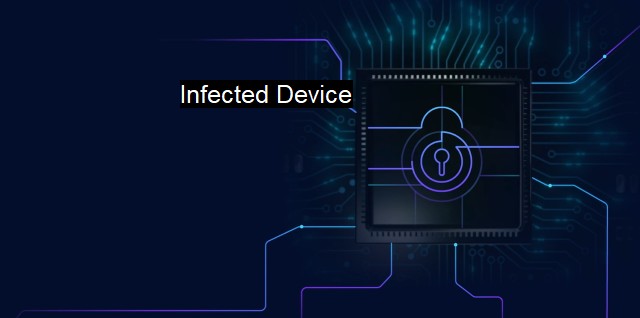What is Infected Device?
Why Infected Devices Pose a Huge Threat to Cybersecurity: Understanding Malware and its Risks
An infected device refers to a computing system, such as a computer, smartphone, or other internet-enabled machine, that has been compromised by a cybersecurity threat or malicious software, often known as malware. When used an infected device usually signifies a gadget or system that has become a host for malware, and whose performance, safety, and the confidentiality of data stored within is imperilled.Malware is an umbrellas term for various types of software deliberately engineered to cause harm to a device, oftentimes without the knowledge or consent of the device’s user. Examples of malware include viruses, worms, trojan horses, spyware, adware, ransomware, and many more. Each type of malware has unique capabilities, including the ability to copy personal data, disrupt device performance, or even take full control of the device.
The process of device infection usually occurs when a user unknowingly downloads or installs infected software or when an infected device connects to the victim's device through a network. Malware can also enter a device through infected email attachments, misleading website pop-up messages, or unsecured Wi-Fi connections.
Device infection has the potential to lead to serious repercussions such as identity theft, a financial loss, or unauthorized access to personal or sensitive information. An infected device may present certain symptoms such as constant crashing, freezing, running significantly slower than before, running out of drive space unexpectedly, or bombarding the user with a large number of unwanted pop-up ads.
Antivirus software plays a critical role in preventing, identifying, and removing device infections. By constantly monitoring the device's activities, accessing a database of known malicious patterns, and utilizing machine learning and artificial intelligence technologies, antivirus software can effectively block threats and clean infections.
Prevention is better than cure. Simple practices can prevent devices from getting infected. This includes downloading applications only from trusted sources, refraining from opening suspicious emails, immunizing removable storage devices before using them, and keeping both the system and the antivirus software up to date.
It’s pertinent to note that in an interconnected world, an infected device not only poses a risk to its owner but also to others on the same network, including corporations or even national infrastructure. Industrious cybercriminals can merge multiple infected devices to create what is known as a botnet, a network of compromised devices used to launch large scale cyber attacks, including Distributed Denial of Service (DDoS) attacks or spam email campaigns.
Both small-scale and large-scale attacks can have enormous implications, from loss of revenue to reputational damage for entities, or a significant threat to national security in some cases. The development and spread of malware are becoming sophisticated, making device infection a growing threat in the ever-evolving world of cybersecurity.
An infected device in the context of cybersecurity and antivirus equates to a device compromised by malware, posing grave risks to individual privacy and cyber peace. Ensuring the safety of our devices through the deployment of robust antivirus systems, practising safe online habits, and staying alert to any change in device behavior can go a long way in preventing device infection and promoting a secure cyber ecosystem.

Infected Device FAQs
What should I do if my device is infected with a virus or malware?
The first thing you should do is to disconnect your device from the internet and any other network connections to prevent the malware from spreading. Then, run a full system scan with your antivirus software to detect and remove the malware. You may also need to restore your device to a previous clean state using a backup or system restore point.How can I prevent my device from getting infected with viruses and malware?
To prevent your device from getting infected with viruses and malware, you should install reputable antivirus software and keep it up to date. You should also avoid clicking on suspicious links or downloading attachments from unknown sources. Keep your operating system and software up to date with the latest security patches and avoid using public Wi-Fi networks whenever possible.What are the signs that my device is infected with malware?
Some common signs that your device is infected with malware include slow performance, unusual pop-ups or error messages, new toolbars or browser extensions, frequent crashes or freezes, and unauthorized changes to your files or settings. If you notice any of these signs, you should run a full system scan with your antivirus software to detect and remove any malware.Can I protect my device from all types of threats with just one antivirus software?
While antivirus software is an essential tool for protecting your device from malware and viruses, it cannot provide 100% protection against all types of threats. Cybercriminals are constantly developing new tactics and techniques to evade detection and compromise security, so it is important to use multiple layers of security, such as firewalls, spam filters, and web filters, in addition to your antivirus software. It is also crucial to practice safe online habits and be cautious of suspicious emails, links, and attachments.| | A | | | B | | | C | | | D | | | E | | | F | | | G | | | H | | | I | | | J | | | K | | | L | | | M | |
| | N | | | O | | | P | | | Q | | | R | | | S | | | T | | | U | | | V | | | W | | | X | | | Y | | | Z | |
| | 1 | | | 2 | | | 3 | | | 4 | | | 7 | | | 8 | | |||||||